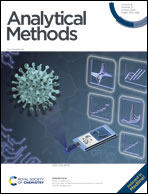Construction of a stable fluorescent sensor based on CsPbBr3/CdS core/shell quantum dots for selective and sensitive detection of tetracycline in ethanol†
Abstract
The weakly bound organic ligand shells around perovskite quantum dots (QDs) are easily decomposed and cannot provide sufficient stability in polar solvents, which greatly obstructs their applications in sensing. Herein, a fluorescent sensor based on CsPbBr3/CdS core/shell QDs was developed for the detection of tetracycline (TC) in the polar solvent-ethanol. Pristine CsPbBr3 QDs were treated with cadmium diethyldithiocarbamate (Cd(DDTC)2) to form a shell on the surface at 110 °C, while extra oleylammonium bromide (OAmBr) was added to inhibit the phase transformation of CsPbBr3 into a Cs4PbBr6 impurity phase during high-temperature processing. And finally CsPbBr3/CdS core/shell QDs were successfully synthesized. The capping with the CdS inorganic shell remediated surface defects and improved the stability in ethanol without affecting the emission properties of the parent CsPbBr3 QDs. The results showed that the fluorescent sensor detected TC in the range of 0.05–25 μM with a low detection limit of 22.6 nM, whereas it had high selectivity and anti-interference ability for TC. And the fluorescence quenching mechanism of the sensor was mainly photoinduced electron transfer between TC and CsPbBr3/CdS QDs. Our research provides a unique way to improve the stability of perovskite QDs in polar solvents and applications in fluorescence detection.



 Please wait while we load your content...
Please wait while we load your content...